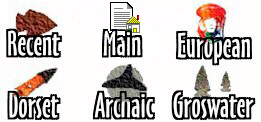![[Header]](ideology.jpg)
![[Header]](ideology.jpg)
The Maritime Archaic Indian cemetery was comprised of three loci, each dating to a specific time period and together ranging from 4300-3200 B.P. In Locus 2, which dates from 4,400-3,600 years ago, there were three groups of burials. One group was associated with Great Auk bills, a second was associated with distinctive gull bones and the third was associated with distinctive pins or pendants that look like miniature swords. This suggests the possibility of three social groups, such as clans.
The Maritime Archaic Indians appear to have believed in an afterlife because they buried with their dead goods to be used in the next life. They also sprinkled red ochre (powdered hematite) around each grave, and on top of the skeleton. It is thought that the red color may represent blood or life. The adults were generally buried in the fetal or flexed position, while children were buried extended. Whether this has any religious significance can only be speculated. Some people feel that the fetal position burials may be representative of a rebirth into the next world. There is evidence of secondary burials where people died somewhere else, and their disarticulated bones were brought to the area for burial. In some cases there was more than one body in a grave, and evidence of disturbance was common. It appears that the Maritime Archaic Indians would dig up a burial to add other members of the family.
The Maritime Archaic Indians were very closely associated with the prey they depended on for survival. Their works of art focussed on seals, birds and whales and may have been worn as amulets by hunters in the belief that they would inherit the characteristics of the animals they hunted. For example, by wearing bear claws around his neck a hunter believed he would have the strength of a bear, or by wearing the jaw of a fox, he would get the fox's swiftness as a hunter.
![]()
Ideology
![]()
